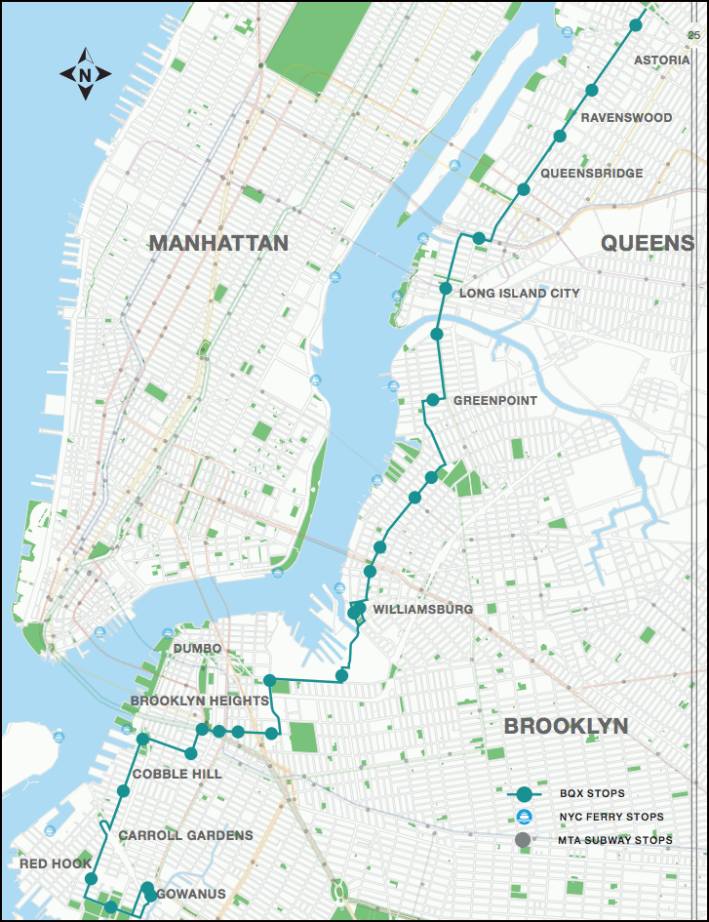The following is written by a civil engineer who works on bus signaling and requested anonymity because the engineer often works with public agencies.
Mayor de Blasio's proposed Brooklyn Queens Connector is lauded as a gamechanger that’ll spur development, generate $30 billion in economic impact, and reduce travel time along an 11-mile route linking growing communities of Gowanus and Astoria. Transit oriented development will prevail! All of this sounds amazing doesn’t it? However the cost of the BQX is estimated to be $2.7 billion. Reminder: $2.7 billion is enormous. Surely there is a comparable alternative. After reading reports by the Mayor’s Office and city Economic Development Corporation [PDF], I am not convinced that the BQX is the best use of our city funds. A Bus Rapid Transit route should cost less and achieve all of the benefits of the BQX. It can work with existing bus routes, spur development, and reduce travel times if correctly implemented. Let’s examine.
Cost
The cost of the BQX is estimated at $2.7 billion. The source of funding for the $2.7 billion is not yet known, but what is known is that acquiring this amount of funding would take years. Instead, the city and state could choose to fund the MTA and improve our overall transit system.
One item included in the cost of the BQX is a $241-million bridge over the Newtown Creek that would connect Manhattan Avenue to Vernon Boulevard. This seems absurdly high, given that the cost of buying new Select Bus Service buses and operating this route would pale in comparison to this bridge. For example, the operating costs for New York City Transit are $30.40 per mile and $215 per hour. If a new SBS route were to follow the same route as the BQX, it would cost $1.9 million per year to operate. This new SBS route can use many existing stops as it follows three different bus routes which would reduce the cost of building a new route.
Route

The proposed route is 11 miles between Gowanus and Astoria. There are 27 stops along this route with the plurality in Downtown Brooklyn and Williamsburg. The proposed BQX route is currently serviced by three bus lines: The B57 (from Gowanus to Downtown Brooklyn), the B62 (from Downtown Brooklyn to Long Island City), and the Q100 (from Long Island City to Rikers). The B57 and B62 run parallel to the proposed BQX while the Q100 overlaps with the final four stops of the BQX. In addition, a BRT can also offer a route that combines parts of all three of the aforementioned bus lines, with no need for eminent domain since the BRT would run on city streets. The bus stops can be reused and most of the right of way is already established. There would be no need to develop the 27 different stations of the BQX. This reduces the cost of the BRT since most of the infrastructure is already there.
The report by EDC also states that 70 percent of the lanes used for the BQX would be exclusive for the streetcar — but that only means that such a dedicated right of way could also be done for the BRT. Currently SBS lanes are often obstructed or slowed down by deliveries and other vehicles. That is why the lanes must be cordoned off with physical infrastructure. Once this is done, the BRT could be equally successful as other BRTs such as the TransMilenio in Bogota, Colombia.
Supporters of the BQX claims that the streetcar would serve 50,000 riders a day and that SBS or BRT cannot compare — but this is false. Currently the B46 services 44,000 riders a day along a 6.5 mile route on Utica Avenue. The light rail is larger and has more capacity, but adding another bus along the route should alleviate this concern and manage passenger wait time. MTA buses also have the added advantage of signal priority. The technology has been proven effective and has improved travel time throughout the different routes.
Ownership
The BQX would be solely owned and operated by the city, as opposed to the BRT route that would be owned by the MTA. This would bypass any need for external funding from the state and approval from Governor Cuomo, which has been the main problem of the MTA. Urban rail has a higher perceived economic benefit than a BRT system because rails and cars feel permanent and bus routes can be easily cancelled or rerouted. In reality, of course, this almost never happens. A true BRT route would attract potential employers and help businesses — especially if New York City Transit President Andy Byford continues to emphasize buses.
Conclusion
A truly dedicated Bus Rapid Transit with dedicated bus-only lanes would be a cheaper and more efficient alternative to the BQX. The BRT system could be built for even less than the cost of the proposed Newtown Creek bridge itself. Many of the benefits of the BQX can be achieved with a BRT such as increasing accessibility to job clusters in Downtown Brooklyn and Long Island City, supporting transit oriented development, and connecting existing and growing communities. The BQX as well has no official city agency that will oversee and operate the system. Who is to say the city won’t delegate the responsibility to the MTA? There are issues with the MTA and they are not the best candidate to oversee this BRT but under new leadership it can and should be done.






